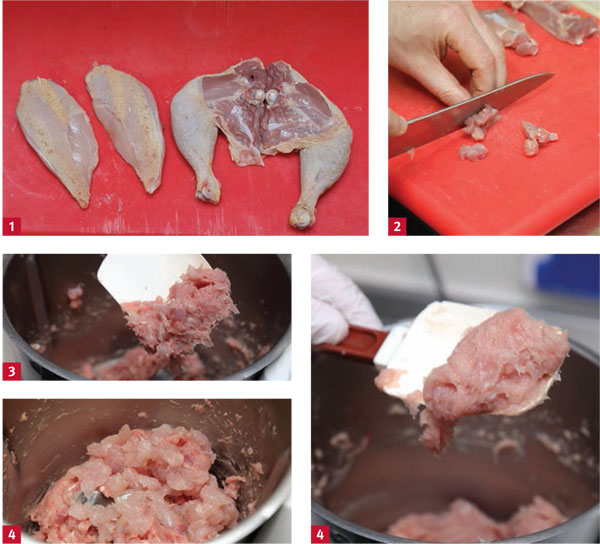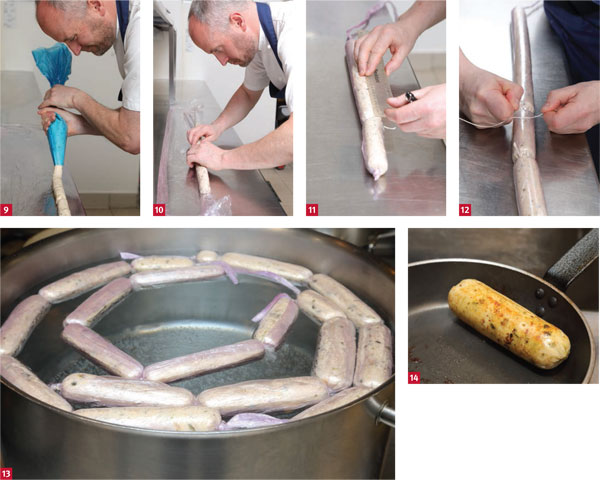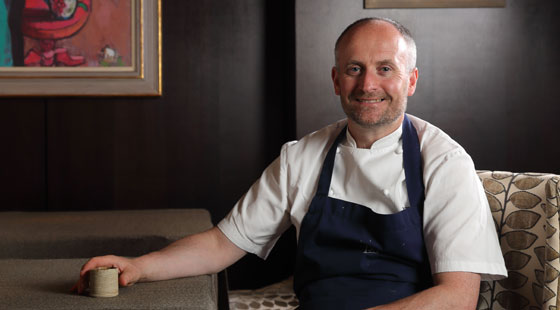Chef masterclass: Andrew Fairlie's boudin blanc
Twelve years on from its first appearance on the Gleneagles restaurant menu, Andrew Fairlie's boudin blanc dish remains almost unchanged. Following the tragic loss of Fairlie, head chef Stevie McLaughlin reveals the recipe to Michael Raffael
The late Andrew Fairlie put ‘boudin blanc' on his à la carte menu at his eponymous restaurant at Gleneagles 12 years ago. The dish is still there, almost unchanged since then, and just as popular. It's a remodelled charcuterie classic; an homage to French culinary know-how, where its success depends on a basic farce recipe allied to practical skills few post-millennial chefs will have mastered.
Fairlie's version starts with a slowly reared 1.2kg chicken from St Brides Poultry in Strathaven, South Lanarkshire (see panel overleaf ). The base is a fine farce as opposed to either coarse-chopped meat or a mousse. It contains skinned, lightly toasted Sicilian pistachios and nuggets of foie gras marinated and poached in JuranÁ§on, and is flavoured with a liberal measure of Armagnac.
Prestige ingredients alone don't guarantee the dish. The succulence and depth of flavour hinge on simple steps, done precisely, at the right temperatures and in the right order.
Stevie McLaughlin, Fairlie's head chef for 12 years, still hand-chops the chicken and beats the farce by hand, and relies on appearance and feel to judge when the texture is just right. The result is a recipe with finesse, worthy of haute cuisine's grand tradition.
Planning
•Chill the mixing bowl over ice.
•Bone the chicken: hand-chop the leg and breast meats separately.
•Machine-chop the leg-meats; add and machine-chop the breast meat.
•Incorporate panade (bread), eggs, a little double cream and some seasoning.
•Chill the mixture; beat in the cream; rest, and then beat in more cream.
•Add pistachios, foie gras and Armagnac.
•Form the boudins, poach and then chill overnight.
•Pan-fry in a non-stick pan and plate with the garnish.
Costing
Restaurant Andrew Fairlie has a £155 tasting menu, a four-course Á la carte at £140 and a three-course Á la carte at £110. The boudin blanc is priced at £38 as a starter.
Boudin blanc de volaille farce
The batch size is based on one 1.2kg chicken, drawn, but head on. It yields approximately 18-20 boudins. Their size is determined by length rather than weight.
1.2kg oven-ready chicken
4 slices of pain de mie, or good-quality white loaf,
crusts removed and cut into 1cm cubes
300ml full-fat milk, warmed
2 medium eggs
2 egg whites
Salt and pepper
400ml double cream, chilled
80g Sicilian pistachios, lightly toasted
200g 1cm cubed cooked foie gras (see panel)
6tbs Armagnac
Remove the breast and legs in the usual way. Discard the skin. Bone out the legs. Reserve the bones and carcass for white chicken stock (part of the kitchen's basic mise en place) (1).
Hand-chop the leg meat and breast to a rough brunoise dice. It's important to use a sharp knife that cuts rather than mashes (2).
Put the diced leg in a Thermomix and blend for 75 seconds on number three (3). Add the diced breast and blend for 75 seconds more (4).
Soak four slices of pain de mie (1cm thick) without crusts - or four slices of a good quality white loaf - in warmed milk (5). Squeeze out as much of the milk by hand as possible (6).
Lightly beat two whole eggs and two whites. Add the bread, egg and a little seasoning to the chicken and blend for a few seconds to incorporate.
Measure 400ml chilled double cream. Pour 120ml into the Thermomix and blend briefly with the chicken, egg and bread. Transfer the mixture to a large chilled mixing bowl.
Note: the next stage must be done over a bowl of iced water and salt. The addition of the salt to the iced water will bring the temperature down a further 2°C.
Spread the farce base up the sides of the bowl so it stays very cold. Beat in half the remaining cream by hand to stretch the proteins (7). Rest at chill temperature. Beat in the rest of the cream. Adjust the seasoning.
Crush the pistachios. Fold them into the farce together with the foie gras and
Armagnac (8).
Forming the boudin
In a traditional boudin, the farce is packed in pork casings. The skinless version suits fine-dining better.
On the work surface, lay a sheet of cling film (120cm x 50cm). Cover it with a second sheet.
Make a neat fold along the length by turning the film edge over a couple of times. This makes it easier to unwrap when the boudin is poached and cooled.
Fill a large disposable piping bag with the farce. Cut the end to about 1.5cm in diameter.
Pipe a strip of farce along the length of the film (9). Leave about 10cm at each end and along the front edge.
Roll up the farce, encasing it in film (10). Tie at 13cm intervals to make the 'sausages' (11).
Repeat the process twice more with the rest of the farce to obtain about 20 boudins (12).
Heat a large pan of water (about 40 litres) to 73°C. Drop the boudins into the water and poach for five minutes. You will notice foie gras fat start to weep from the boudin (13).
Take the pan off the heat and let the boudins cool in the water under the cover of a clean tea towel. Remove them and chill until service.
Boudin blanc, morels, asparagus, Madeira sauce
The garnishes will change with the season.
Serves 1
1 boudin blanc
Trimmed asparagus spears
Sautéed morels
1-2tbs truffled madeira jus
Marmite butter (see note)
Take the film wrapping off the boudin. Heat a Teflon pan over a moderate flame. Put the boudin in it and, keeping it moving so the surfaces colour evenly, reheating for about five minutes (14).
To serve, arrange on the plate with the asparagus and morels. Pour over the hot Madeira sauce. Brush the boudin with Marmite butter.
Note: The Marmite butter - a little Marmite infused in melted butter - gives an almost imperceptible umami taste that adds to the mouthfeel.
For the foie gras
the liver in a light brine. Separate the two lobes and remove the veins. Marinate for 12 hours in JuranÁ§on, sel rose, sugar, mace and white pepper. Form into a long cylinder between sheets of cling film.
Poach in a water bath at 68°C until it reaches this core temperature. Chill. For the boudin Cut 200g foie gras into 1cm slices. Cut each slice into cubes and freeze.
St Bride's Free Range Poulty
St Bride's Free Range Poultry specialises in the Hubbard variety, which is a hybrid bird from various strains, including Cornish White and Rhode Red. It is a Label Rouge-certified breed and hardy enough to be reared in an outdoor setting.
The birds are grown for minimum of 120 days and free to roam during daylight hours. The grass in the birds' diet gives them a yellowing of the fat, particularly prevalent in the summer. Being able to roam freely encourages muscle tone and formation of healthy bones with the development of bone marrow, which results in great-tasting stock.
Madeira and truffle jus
15ml light olive oil
60g shallots
30g button mushrooms, thinly sliced
1 small garlic clove
240ml Madeira
120ml good chicken stock
450ml brown veal stock
15g fresh black truffle
Salt and pepper
Sweat the shallot, mushrooms and garlic in olive oil until soft and translucent. Add 220ml of Madeira and reduce to a syrup. Add the chicken stock and reduce
by half. Add the veal stock and simmer until the sauce coats the back of a spoon. Squeeze the sauce through a fine chinois into a clean sauce pan. Add all the truffle and allow to infuse in the warm sauce for 15 minutes.
Correct the seasoning and add a few remaining drops of Madeira to 'freshen' the sauce.
Serve hot and generously.
Stevie McLaughlin
Most ambitious young chefs build their careers by moving around. They spend a couple of years here, a couple there and they graft a few stages onto their CVs until they become chefs. Stevie McLaughlin is in a unique position. He has
spent 25 years under the wing of one man, Andrew Fairlie, following him from 1 Devonshire Gardens in Glasgow to Gleneagles in Auchterarder, Perthshire.
The trajectory has a bittersweet context. His mentor's diagnosis with a brain tumour more than a decade ago created a special professional relationship between the two men. For much of the time Fairlie was in remission, still running the kitchen, McLaughlin was his head chef.
For the last three years, when Fairlie's condition was worsening, McLaughlin oversaw the restaurant. During that time, neither the customers nor the guides would have noticed any differences in style or quality. "If a customer asked to speak with Andrew," McLaughlin admits, "we'd say it was the chef's night off."
Total immersion in one place has given an enviable level of self-assurance: "Being here for 18 years doesn't mean I've been in the same job for 18 years. I've
done everything in the kitchen. I wasn't always the head chef. I was senior sous and working sections. Andrew was cooking then."
The continuity allowed him, he believed, to hone his palate to the house tastes and textures. "Nothing is taken for granted, down to the smallest detail, such as how coriander should taste. Cooking is an emotional thing, both for the cook and for the person eating; how you use every ingredient needs care."
Fairlie's influence may be a part of McLaughlin's DNA, but it hasn't stopped him developing his own style: "Until a couple of years ago there was still a lot of planning and guiding and discussing dishes."
That day-to-day partnership faltered towards the end, with the announcement that Fairlie had stepped away from the kitchen in early November 2018. He passed away 11 weeks later.
McLaughlin regards himself as carrying on the legacy he inherited. That also applies to the kind of kitchen he runs: "Andrew only wanted to work with people he liked. He only wanted to work with friends. He only wanted to work with people he trusted. Nothing has changed.
"I'm not going to take risks or rock the boat. I'm not going to do anything that would jeopardise something that has taken 18 years to create. But equally, I'm going to have fun; I shan't stop innovating because Andrew isn't here.
"Ten years from now I'd like to imagine him looking down, taking the lid off the business and being proud of us. I know we could stand still and it would still be a good restaurant, but we want to be better. We want to evolve as chefs and we want to evolve as people."
Continue reading
You need to be a premium member to view this. Subscribe from just 99p per week.
Already subscribed? Log In














